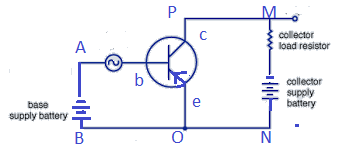
Answer
110.7k+ views
Hint: Transistor when supplied with a voltage source at two of its terminals let’s say emitter and base and output is produced at the other two terminals let’s say emitter and collector is performed as an amplifier. Using the above hint we will find out which type of transistor is used in the circuit given in the question above and how it is acting as an amplifier.
Complete step by step solution:
Let’s answer each of point mentioned in the question one by one:
i) The figure shown in the question above circuit diagram represents an Amplifier. Transistor when connected in an active region at both the combination of terminals i.e. emitter base and emitter collector. Active region means that the voltage source connected to an emitter base region and emitter collector region should be forward biased. The above amplifier is a p-n-p transistor common emitter Amplifier. Amplifier is an electronic device which strengthens the weak signal by raising its strength.
ii) Input voltage is applied at the AB terminal of the emitter base junction and the output voltage is produced at MN terminal across the load resistor with an amplified signal.
iii) Output voltage of the amplifier having common emitter configuration is 1800 out of phase as compared to input voltage. The reason for this is that when the input voltage is applied, current through the base circuit increases, which increases the current through the collector circuit also. This collector current lets the transistor on and makes the emitter collector voltage to fall below emitter base voltage, which brings a 1800 phase shift.
Note: Transistor works as amplifier in active region and acts as switch in cut off and saturation regions. Cut off region or saturation is the one in which both the regions of the transistors are reversed bias, base and emitter collector regions. Transistors give 1800 phase shifts only in common emitter configuration.
Complete step by step solution:
Let’s answer each of point mentioned in the question one by one:
i) The figure shown in the question above circuit diagram represents an Amplifier. Transistor when connected in an active region at both the combination of terminals i.e. emitter base and emitter collector. Active region means that the voltage source connected to an emitter base region and emitter collector region should be forward biased. The above amplifier is a p-n-p transistor common emitter Amplifier. Amplifier is an electronic device which strengthens the weak signal by raising its strength.
ii) Input voltage is applied at the AB terminal of the emitter base junction and the output voltage is produced at MN terminal across the load resistor with an amplified signal.
iii) Output voltage of the amplifier having common emitter configuration is 1800 out of phase as compared to input voltage. The reason for this is that when the input voltage is applied, current through the base circuit increases, which increases the current through the collector circuit also. This collector current lets the transistor on and makes the emitter collector voltage to fall below emitter base voltage, which brings a 1800 phase shift.
Note: Transistor works as amplifier in active region and acts as switch in cut off and saturation regions. Cut off region or saturation is the one in which both the regions of the transistors are reversed bias, base and emitter collector regions. Transistors give 1800 phase shifts only in common emitter configuration.
Recently Updated Pages
Write an article on the need and importance of sports class 10 english JEE_Main

Write a composition in approximately 450 500 words class 10 english JEE_Main

Arrange the sentences P Q R between S1 and S5 such class 10 english JEE_Main

If x2 hx 21 0x2 3hx + 35 0h 0 has a common root then class 10 maths JEE_Main

The radius of a sector is 12 cm and the angle is 120circ class 10 maths JEE_Main

For what value of x function fleft x right x4 4x3 + class 10 maths JEE_Main

Other Pages
Electric field due to uniformly charged sphere class 12 physics JEE_Main

If a wire of resistance R is stretched to double of class 12 physics JEE_Main

In Searles apparatus when the experimental wire is class 11 physics JEE_Main

The energy stored is a condenser is in the form of class 12 physics JEE_Main

Excluding stoppages the speed of a bus is 54 kmph and class 11 maths JEE_Main





